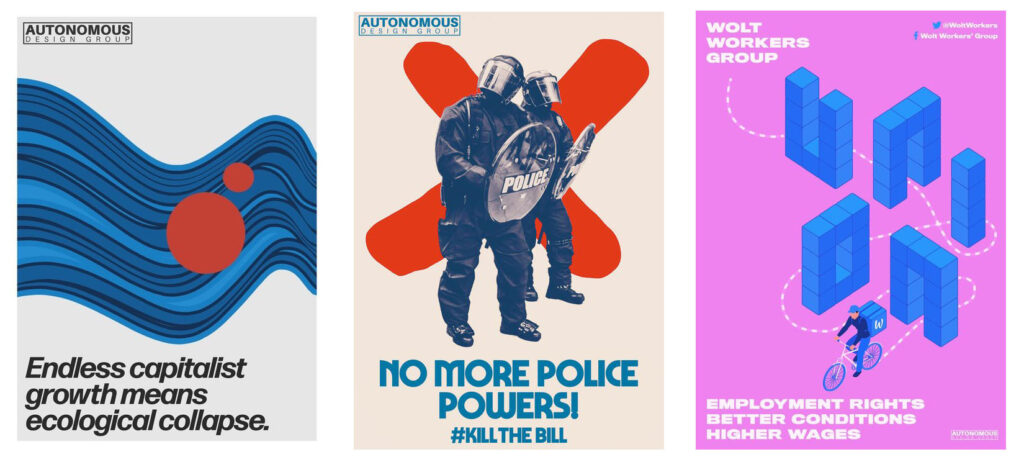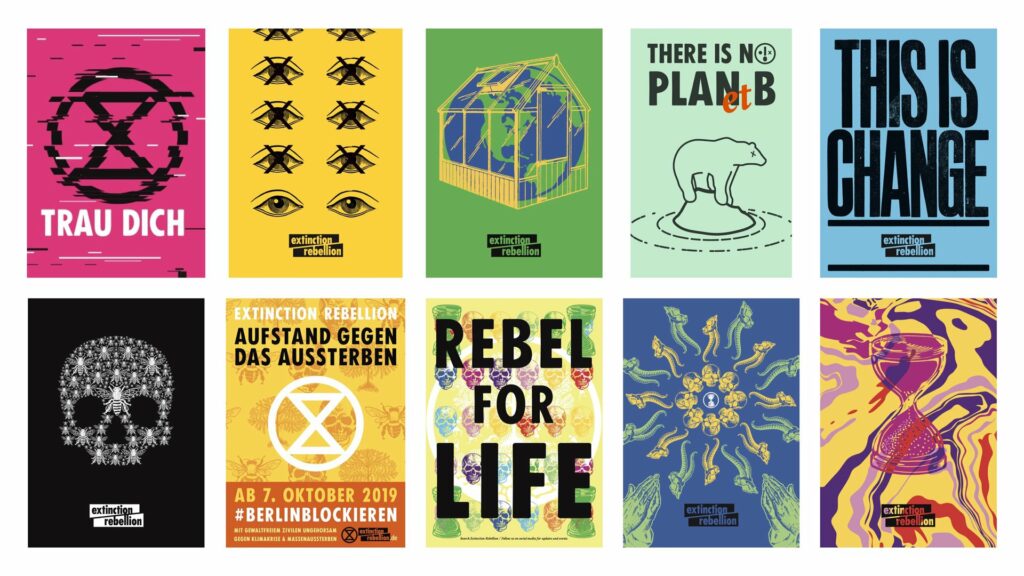Even tough many pronounced the poster as a dead medium, Social Poster Design has not seen any decline in popularity in the last 10 years. Maybe today’s poster have to be a little more versatile (so they can be shared via social media etc.) but the myriad of social problems and injustice issues have kept the poster production going. From Pussy Riot, Black Lives Matter, Je suis Charlie, Brexit and Peta to anti-war protests, the stream of examples does not seem to end.
It is difficult to keep track of the may variations of styles and getting an overview of all of today’s social posters might prove impossible. For this reason, I decided to narrow my focus a little bit again and searched for examples that were inspired by famous social poster styles from the past such as Atelier Populaire. In doing so, I came across an article with the title „Designing for social justice: What does it mean to create radical posters for the 21st Century?” in “It’s nice that”. The article featured two artist collectives of young designers working in the social sphere: Labour Party Graphic Designers and Autonomous Design Group (Hingley, 2022a).
The designers from both collectives describe their approach to design as anti-commercial: Sana Iqbal states in the article that “As a result of this commercialisation, ‘the centralisation of design has lost it’s grounding and it feels like a giant sales machine, which I just don’t care for’. It’s this very approach that LPGD are trying to tackle – that being the ephemeral, disposable nature of careless political design” (Hingley, 2022a).

For this, the collectives draw inspiration from 20th century design movements and name Atelier Populaire, the See Red Women’s Workshop and the OSPAAAL (Organisation of Solidarity with the People of Asia, Africa and Latin America) as their role models (source 1). With this comes a very distinct poster style: “They see the importance in reinstating a sense of vibrancy, colour and visual distinctiveness in their posters, which is something that will set them apart from the dreary monotony plaguing current political design. And finally, they want to move away from overcomplication, and focus instead on simplicity and accessibility” (Hingley, 2022a).

Also in this direction goes designer Harriet Richardson, who has risen to fame lately for her funny and thought-provoking protest posters (Hingley, 2022b).

Harriet states in an interview, that simplicity is one of her main methods when coming up with new poster/slogan ideas: “I think conveying a message can be done in so many ways, but simple straightforward ‘punchy slogans’ have been proven to do the job over many years” (Hingley, 2022b). This is especially visible in her poster series “Don’t look directly at The Sun” (referencing the British tabloid paper “The Sun”), which is reminiscent of the simple colored posters from Atelier Populaire.

In addition, traces of this very simple graphic language featuring a hand-made look and bold colours one could also name Extinction Rebellion, a group of non-violent climate activists who rose to fame in 2018. Their visual identity was created by the movement’s art group: “This Ain’t Rock’ n’ Roll (identity + activism for culture + causes)” (Bloem & Kempenaars, 2019). When asked about their inspiration, a member of the group states that “[i]n its actual manifestation, we drew a lot of inspiration from Paris ‘68” (Bloem & Kempenaars, 2019, p. 26). This can also be observed when looking at the posters Extinction Rebellion offers for free download on their website:

To sum this up, it seems very difficult to get a general grip of today’s social poster design due to the wide variety of causes and styles. However, some young designers draw inspiration from 20th century examples like the Atelier Populaire and use a simple, bold design style to convey their message. This goes also along with the previous findings about what an effective social poster should look like. Amongst others, a striking visual language and a certain translatory role as well as simplicity were named as positive contributors (see: previous blogposts), which we can definitively observe here.
It seems like the social poster is anything but dead and is constantly evolving and transforming, being an outlet of creativity, rallying for an important cause.
References
- Autonomous Design Group. (n.d.). Autonomous Design Group poster works. https://www.weareadg.org/
- Bloem, I., & Kempenaars, K. (2019). Branded Protest: The power of branding and its influence on protest movements. BIS Publishers.
- Extinction Rebellion. (n.d.). Extinction Rebellion Poster Vorlagen. https://extinctionrebellion.de/mitmachen/material/grafik/
- Hingley, O. (2022a, May 25). Designing for social justice: What does it mean to create radical posters for the 21st Century? It’s Nice That. Retrieved January 25, 2023, from https://www.itsnicethat.com/features/radical-poster-graphic-design-250522
- Hingley, O. (2022b, December 19). From Pentagram to political slogans: Designer Harriet Richardson on her witty and disruptive practice. It’s Nice That. Retrieved January 25, 2023, from https://www.itsnicethat.com/features/harriet-richardson-spotlight-graphic-design-191222
- Labour Party Graphic Designers. (2019). LPGD Art Pack Summer ’19 Climate Emergency. https://www.labourdesign.co.uk/art-packs/summer-19-climate-emergency
- Richardson, H. (n.d.-a). Harriet Richardson. Design Manchester. https://designmcr.com/artists/harriet-richardson
- Richardson, H. (n.d.-b). Sun Mini Set. Harriet Richardson. https://artschoolmembersclub.com/shop/p/sun-minis